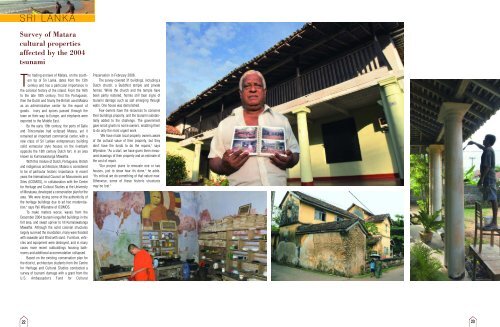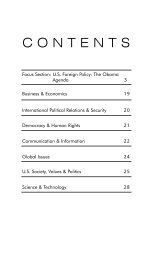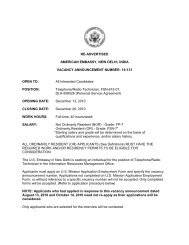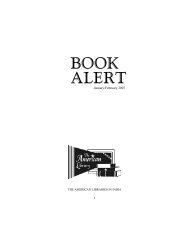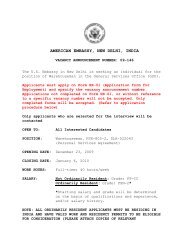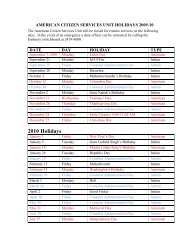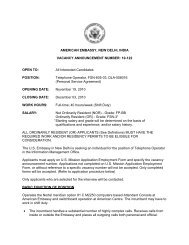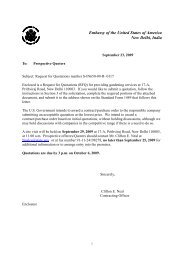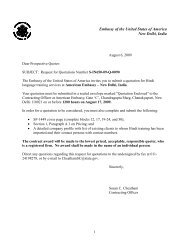Sri Lanka - New Delhi
Sri Lanka - New Delhi
Sri Lanka - New Delhi
Create successful ePaper yourself
Turn your PDF publications into a flip-book with our unique Google optimized e-Paper software.
SRI LANKASurvey of Mataracultural propertiesaffected by the 2004tsunamiThe trading enclave of Matara, on the southerntip of <strong>Sri</strong> <strong>Lanka</strong>, dates from the 13thcentury and has a particular importance inthe colonial history of the island. From the 16thto the late 18th century, first the Portuguese,then the Dutch and finally the British used Mataraas an administrative center for the export ofgoods. Ivory and spices passed through thetown on their way to Europe, and elephants wereexported to the Middle East.By the early 19th century, the ports of Galleand Trincomalee had eclipsed Matara, yet itremained an important commercial center, with anew class of <strong>Sri</strong> <strong>Lanka</strong>n entrepreneurs buildingsolid vernacular style houses on the riverbankopposite the 18th century Dutch fort, in an areaknown as Kumarawatunga Mawatha.With this mixture of Dutch, Portuguese, Britishand indigenous architecture, Matara is consideredto be of particular historic importance. In recentyears the International Council on Monuments andSites (ICOMOS), in collaboration with the Centrefor Heritage and Cultural Studies at the Universityof Moratuwa, developed a conservation plan for thearea. "We were losing some of the authenticity ofthe heritage buildings due to ad hoc modernization,"says Pali Wijeratne of ICOMOS.To make matters worse, waves from theDecember 2004 tsunami engulfed buildings in thefort area, and swept upriver to hit KumarawatungaMawatha. Although the solid colonial structureslargely survived the inundation, many were floodedwith seawater and filled with sand. Furniture, vehiclesand equipment were destroyed, and in manycases more recent outbuildings housing bathroomsand additional accommodation collapsed.Based on the existing conservation plan forthe district, architecture students from the Centrefor Heritage and Cultural Studies conducted asurvey of tsunami damage with a grant from theU.S. Ambassador's Fund for CulturalPreservation in February 2006.The survey covered 31 buildings, including aDutch church, a Buddhist temple and privatehomes. While the church and the temple havebeen partly restored, homes still bear signs oftsunami damage such as salt emerging throughwalls. One house was demolished.Few owners have the resources to conservetheir buildings properly, and the tsunami substantiallyadded to the challenge. The governmentgave small grants to some owners, enabling themto do only the most urgent work."We have made local property owners awareof the cultural value of their property, but theydon't have the funds to do the repairs," saysWijeratne. "As a start, we have given them measureddrawings of their property and an estimate ofthe cost of repair."Our project plans to renovate one or twohouses, just to show how it's done," he adds."It's critical we do something of that nature now.Otherwise, some of these historic structuresmay be lost."2223
Survey of theWestern Monasteries,Anuradhapura,<strong>Sri</strong> <strong>Lanka</strong>Anuradhapura is a place of monumentalBuddhist stupas and massive reservoirs setamid emerald rice fields, reminders of amajor civilization that arose soon after Buddhismcame to <strong>Sri</strong> <strong>Lanka</strong> in the third century before thecurrent era. The culture was heavily steeped inBuddhist monastic practice, and produced atAnuradhapura some of the most important religiousmonuments on the island over a period of about1200 years until its decline in the 10th century.The scale of the development was immense.The Jethawanaramaya Stupa, 120 meters tall, is thebiggest Buddhist stupa in the world and the tallestbrick building ever built. Monasteries had capacityfor as many as 3,000 monks and evolved sophisticateddesigns which included ritual, residential andservice buildings.Beginning in the sixth century, Anuradhapurawas home to reclusive communities of monks.Until recently, the monasteries in which they livedremained undocumented, occupying an overgrownarea on the periphery of the old city.A survey of the Western Monasteries wasbegun in 2006 under a grant to the <strong>Sri</strong> <strong>Lanka</strong>nCentral Cultural Fund by the U.S. Ambassador'sFund for Cultural Preservation. The survey is servingas a basis for development of a comprehensiveconservation plan and contributing to the documentationof Anuradhapura, only about 25 per centof which has been surveyed.The architecture of the monasteries is substantiallydifferent from others at the site. Thestyle, which emerged in the sixth century, consistsof two buildings raised on twin platformsconnected by a bridge. One building, always surroundedby a moat, is likely to have been residential,while its twin would have been a prayer hall.The design took advantage of existing topography,building on rock outcrops where naturaldepressions provided a water supply for the moat.All 13 complexes were probably built within thespace of one century. "This is a completelyunique style of architecture. It only exists in <strong>Sri</strong><strong>Lanka</strong>," says Wajira Ferdinandez, the conservationarchitect in charge of the survey.The absence of kitchens, refectories andlibraries found in other monasteries suggests thatthe monks practiced an extreme asceticism, livingby begging and focusing on meditation rather thanstudy, says Ferdinandez. Decorative carving isalmost completely absent from the buildings.Prior to the beginning of the survey inDecember 2006, the buildings were overgrown andin an advanced state of collapse. The project is thefirst comprehensive survey of the site, and includesa digital map using GPS locations, digital drawingsof the monuments, photographic documentationand preparation of a technical report on the conditionof the site.Mapping boundaries and identifying encroachmentsare a top priority. Ferdinandez says that thesite has suffered in recent decades from pilferageby nearby villagers. At one monastery site, all thatremain are grooves in the rock showing where thebuilding once lay.The survey is being implemented through theCentral Cultural Fund, <strong>Sri</strong> <strong>Lanka</strong>'s principal heritagemanagement body, established in 1980 with thePrime Minister as Chairman.2425


